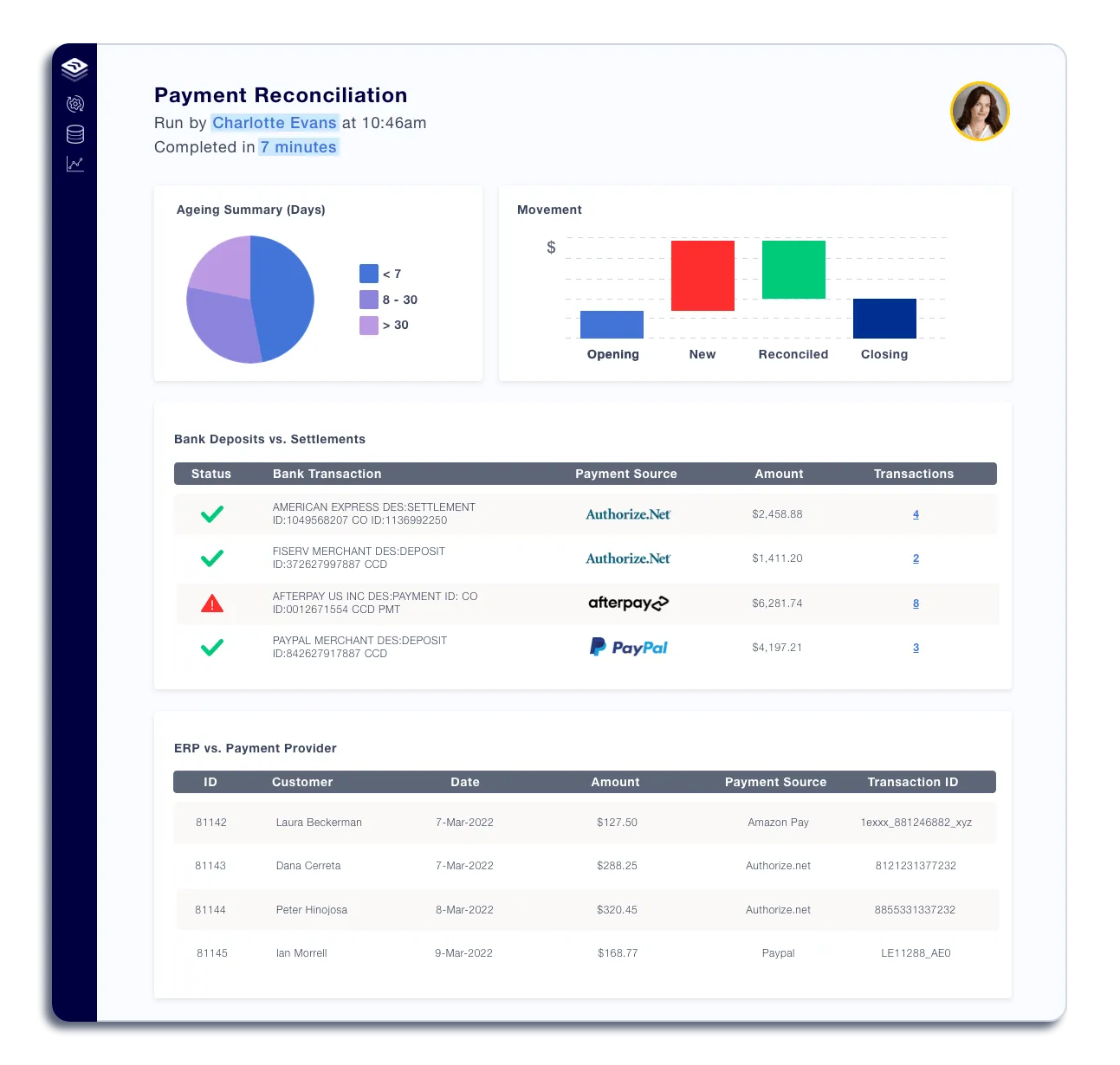Mastering Automated Payment Reconciliation: A Comprehensive Guide

In financial management, automated payment reconciliation has emerged as a game-changing solution for businesses of all sizes.
This comprehensive guide will walk you through the intricacies of this powerful process, helping you understand its importance, implementation, and future potential.
Coming Up
Introduction to Automated Payment Reconciliation
Automated payment reconciliation is a sophisticated financial process that leverages technology to automatically match and verify transactions across multiple systems. It involves comparing financial records from various sources, such as bank statements, invoices, and internal accounting systems, to ensure accuracy and identify discrepancies without manual intervention.
At its core, payment reconciliation is crucial for maintaining financial integrity and compliance. It helps businesses detect errors, prevent fraud, and clearly understand their financial health. Automating this process further enhances these benefits by dramatically reducing the time and resources required while simultaneously improving accuracy.
Traditional manual reconciliation methods are prone to human error and can be incredibly time-consuming, especially for businesses with high transaction volumes. Automated systems, on the other hand, can process vast amounts of data quickly and accurately, freeing up finance teams to focus on more strategic tasks.
Why Implement Automated Payment Reconciliation?
Automating payment reconciliation can significantly impact a company's financial operations and overall business performance. Here are compelling reasons businesses increasingly adopt automation for this critical financial task.
Benefits of Automation
- Enhanced Accuracy: Automated systems minimize human error, ensuring accurate reconciliations. This accuracy is crucial for maintaining the integrity of financial statements and making informed business decisions.
- Time Efficiency: Automation dramatically reduces processing time. What once took days or weeks can now be accomplished in hours or minutes.
- Cost Savings: By reducing the need for manual labor, businesses can reallocate resources to more value-added activities.
- Improved Fraud Detection: Automated systems can quickly identify unusual patterns or discrepancies that might indicate fraudulent activity, providing additional security for your financial operations.
- Better Cash Flow Management: With real-time visibility into transactions and account balances, businesses can make more informed decisions about cash management and investment strategies.
- Scalability: As your business grows and transaction volumes increase, automated systems can easily handle the additional workload without a proportional increase in resources or time. .
- Compliance and Audit Trail: Automated reconciliation systems maintain detailed logs of all activities, making it easier to demonstrate compliance with regulatory requirements and simplify audit processes. This ensures that all transactions are tracked and verifiable, reducing the risk of non-compliance penalties.
- Reduced Stress on Finance Teams: Automating tedious manual tasks can improve job satisfaction and allow finance professionals to focus on more strategic, value-added work.
These benefits collectively contribute to more robust financial health for businesses. This speed improves operational efficiency and provides timely insights for strategic decision-making.
Comparing Manual and Automated Reconciliation
To fully appreciate the value of automated payment reconciliation, it's essential to understand how it compares to traditional manual methods. This comparison will highlight scenarios where each approach might be appropriate and demonstrate why automation is increasingly becoming the business's preferred choice.
Manual Reconciliation
Manual reconciliation involves human operators comparing financial records, typically using spreadsheets or basic accounting software. This method has been the standard for many years and still has some applications:
- Suitable for: Small businesses with low transaction volumes or infrequent reconciliation needs.
- Advantages:
- Low initial cost (no specialized software required)
- Direct human oversight for each transaction
- Flexibility in handling unique or complex transactions
- Disadvantages:
- Time-consuming and labor-intensive
- Higher risk of human error
- Limited scalability as transaction volumes grow
- Difficulty in maintaining consistent processes across an organization
Automated Reconciliation
Automated reconciliation uses specialized software to match and verify transactions across multiple systems without manual intervention:
- Suitable for Businesses of all sizes, especially those with high transaction volumes or complex financial structures.
- Advantages:
- Significant time savings (up to 80% reduction in reconciliation time)
- Higher accuracy and consistency
- Scalable to handle large volumes of transactions
- Real-time or near-real-time processing capabilities
- Advanced analytics and reporting features
- Disadvantages:
- Initial investment in software and implementation
- It may require staff training and process adjustments
While manual reconciliation might still be appropriate for very small businesses or unique situations, the benefits of automation become increasingly apparent as organizations grow and financial complexity increases. Automated systems can handle the reconciliation of thousands of transactions in minutes, which could take days or weeks to complete manually.
Moreover, automated systems excel in environments where consistency is crucial. They apply the same rules and checks to every transaction, eliminating variations that can occur with different human operators. This consistency is particularly valuable for businesses operating across multiple locations or dealing with international transactions.
Implementing Automation in Reconciliation
Transitioning to an automated payment reconciliation system requires careful planning and execution. Follow these steps to ensure a smooth implementation:
Tools and Technologies for Automation

The market offers a variety of tools designed to automate payment reconciliation processes. When selecting the right solution for your business, consider your company size, industry, transaction volume, and specific reconciliation needs. Here are some types of automation tools and features to look for:
Types of Automation Software
- Stand-alone Reconciliation Tools: Focused specifically on automating the reconciliation process.
- Integrated Financial Suites: Offer reconciliation as part of a broader set of financial management tools.
- ERP System Modules: Reconciliation features integrated into enterprise resource planning systems.
- Cloud-based Solutions: Offer flexibility, scalability, and accessibility from anywhere.
Key Features to Consider
- Data Import Capabilities: Easily importing data from various sources and formats.
- Matching Algorithms: Sophisticated rules for identifying and pairing transactions.
- Exception Handling: Tools for efficiently managing and resolving discrepancies.
- Reporting and Analytics: Customisable reports and dashboards for insights and audit trails.
- Integration Options: APIs and connectors for seamless integration with existing systems.
- Security Measures: Robust data protection and user access controls.
- Scalability: Ability to handle growing transaction volumes and complexity.
Leading Industry Tools
While there are many options available, here are a few notable tools in the automated reconciliation space:
- Solvexia: A comprehensive automation platform that excels in reconciliation processes. It offers powerful data-matching capabilities, custom workflow creation, and advanced analytics, making it suitable for businesses of various sizes and industries.
- BlackLine: Known for its cloud-based financial close and reconciliation solutions, BlackLine is popular among large enterprises.
- Fiserv Frontier: Specialises in reconciliation for financial institutions, offering modules for various types of financial transactions.
- ReconArt: Provides end-to-end reconciliation and exception management solutions focusing on flexibility and customization.
- Trintech Adra: Offers a suite of financial close management tools, including automated reconciliation, designed for mid-market organizations.
When evaluating these or other tools, it's crucial to consider your specific business needs, budget, and growth plans. Many providers offer demo versions or trial periods, which can be invaluable in assessing the fit for your organization.
Wrap-Up: Future Trends in Payment Reconciliation
As we look to the future, the landscape of automated payment reconciliation continues to evolve, driven by technological advancements and changing business needs. Here are some key trends shaping the future of this critical financial process:
- Artificial Intelligence and Machine Learning:
- AI-powered systems will enhance pattern recognition in transaction data, improving fraud detection and anomaly identification.
- Machine learning algorithms will continually refine matching rules, increasing accuracy and reducing exceptions over time.
- Blockchain Technology:
- Distributed ledger technology could revolutionize reconciliation by providing a single, immutable source of truth for transactions.
- Smart contracts may automate complex reconciliation processes across multiple parties.
- Real-time Reconciliation:
- As payment systems become faster, reconciliation processes must keep pace, moving towards continuous, real-time matching and verification.
- Advanced Analytics and Predictive Capabilities:
- Future tools will reconcile past transactions, forecast potential discrepancies, and suggest preventive measures.
- Integration with Emerging Payment Methods:
- Reconciliation systems will adapt to handle new payment technologies, including cryptocurrencies and decentralized finance platforms.
- Enhanced Collaboration Features:
- Tools will increasingly support cross-functional collaboration, allowing for seamless communication between finance, operations, and other departments during reconciliation.
- Regulatory Technology (RegTech) Integration:
- Automated reconciliation systems will incorporate more robust compliance checks and reporting features to meet evolving regulatory requirements.
In conclusion, mastering automated payment reconciliation is becoming increasingly crucial for businesses looking to stay. By understanding the benefits, implementing the right tools, and staying abreast of emerging trends, organizations can transform their financial operations, reduce risks, and unlock new opportunities for growth and innovation.
Whether you're just starting to explore automation or looking to optimize your existing processes, the journey toward efficient, accurate, and insightful payment reconciliation is an investment in your company's financial future. As you move forward, consider partnering with experienced providers, staying informed about technological advancements, and continuously refining your processes to maximize the benefits of automation in your financial operations.
FAQ
Intelligent reconciliation solution
Intelligent rebate management solution
Intelligent financial automation solution
Intelligent Financial Automation Solution
Intelligent financial automation solution
Intelligent financial automation solution
Intelligent financial automation solution
Intelligent financial automation solution
Intelligent regulatory reporting solution
Free up time and reduce errors
Recommended for you

Request a Demo
Book a 30-minute call to see how our intelligent software can give you more insights and control over your data and reporting.

Reconciliation Data Sheet
Download our data sheet to learn how to automate your reconciliations for increased accuracy, speed and control.

Regulatory Reporting Data Sheet
Download our data sheet to learn how you can prepare, validate and submit regulatory returns 10x faster with automation.

Financial Automation Data Sheet
Download our data sheet to learn how you can run your processes up to 100x faster and with 98% fewer errors.

Financial Automation Data Sheet
Download our data sheet to learn how you can run your processes up to 100x faster and with 98% fewer errors.

Financial Automation Data Sheet
Download our data sheet to learn how you can run your processes up to 100x faster and with 98% fewer errors.

Financial Automation Data Sheet
Download our data sheet to learn how you can run your processes up to 100x faster and with 98% fewer errors.

Financial Automation Data Sheet
Download our data sheet to learn how you can run your processes up to 100x faster and with 98% fewer errors.

Financial Automation Data Sheet
Download our data sheet to learn how you can run your processes up to 100x faster and with 98% fewer errors.

Rebate Management Data Sheet
Download our data sheet to learn how you can manage complex vendor and customer rebates and commission reporting at scale.

Top 10 Automation Challenges for CFOs
Learn how you can avoid and overcome the biggest challenges facing CFOs who want to automate.
.svg)





